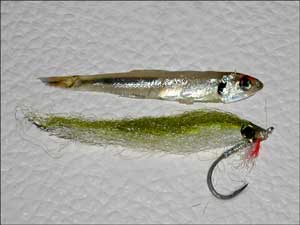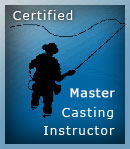Flies that Imitate Baitfish
This winter has been tough for those of us that prefer the long rod. Back to back cold fronts, constant high winds, water that is stirred up and murky, and bone-chilling water temperatures, have been with us longer than I care to remember. Within the last week, spring for fishermen has finally arrived. The improvement in water temperatures brought on by milder weather has reintroduced fish that seemed to have disappeared.
A recent inshore charter had us slowly dragging shrimp and crab imitations on the bottom to tempt the lethargic predators with mediocre results. As we fished the drop-off of a usually productive flat, I noticed a large pod of baitfish at a pointed edge that were only an inch and a half in size. I eased a small mushroom anchor in position and selected a “glass minnow pattern,” that was close to the size of the baitfish. The first cast with a sinking tip fly line immediately produced a nice trout. For the next ten or fifteen minutes, few casts went without a cooperative strike. A pattern now developed that continued to produce. Were the fish finally turning on? Did we finally locate a school of dumb trout? What was the key to our success?
Giving them what they wanted, “matching the hatch,” I feel, was the most important factor. How can fish be reckless one day and turn up their nose at our beautiful flies the next time out? When you pick up your fly rod with the same pattern that was “a killer a few days ago,” and now seems to be ignored by everything, could it be that the fish decided to be a little more selective? The sudden availability of food may not make them reckless. When there are thousands of natural baits everywhere, why should they take your feathered offering? The fish will tell you what they want if you take the time to do more observing and less casting.
We will concentrate on size, shape or silhouette, color, and appearance of baitfish.

Can we level the playing field by closely duplicating Mother Nature? The recent explosion in saltwater fly fishing has spawned an increase in new materials that make flies more natural looking. A well-equipped fly shop or catalogue will give you a headache trying to select a pattern. A local fly pattern that has a proven track record is always a good start. Your area will have someone who can help in narrowing your choices. When I go to a new area, I always visit a good fly shop to see what local patterns or variations are productive. Since I tie my own, I will purchase some flies and take them home to reproduce them. New materials may be necessary to accomplish this, and they should be available there. Most good shops have a fly tying vise set up and if time permits will even show you how to tie the fly.
The following are some baitfish patterns that have proven themselves in the salt. Lefty Kreh’s Deceiver is an old standby. His favorite variation is mostly white with a chartreuse topping and red throat. This gives an excellent imitation of the Greenbacks that provide most of the food for our predators. Bob Clouser’s Deep Minnow, or Clouser Minnow has to be next. The same color combination of chartreuse over white makes this pattern a necessity. By using different size weighted or dumbbell eyes this fly will probe deeper water more effectively. Since the hook point rides up, this pattern has the added advantage of bouncing on the bottom without getting fowled. A newer pattern has recently emerged when these two outstanding fly fisherman combined their talents and developed a Half and Half, a fly that combines the best features of both flies. A friend of mine, Dave Hadden, who works for Heritage Kayaks, gave me a few of these when we were fishing together recently that he ties for Northeast Stripper fishing. It didn’t take me long to sit down at the vise and downsize the pattern a little to duplicate the smaller baitfish that are here now. Another pattern, a Bendback style fly, tied properly is very snag free making a weed guard unnecessary. Originally tied with bucktail, stiffer synthetic materials help so when you cast a little too far into the mangroves or over a dock line a slow tease will get you out of trouble. Addition of eyes to all patterns adds to their appeal.
Dan Sauvageau, of Dan’s Custom Flies, who has a pattern that he features every month in this magazine, always has a fish tank at his displays that allows you to have a fish eye’s view of how flies look to your quarry. The pattern that hooked you in the fly selection may stick out like a sore thumb when in the water. Many older standbys have been improved with the newer synthetic materials making them more translucent. I’ve night fished for snook with Dan, and we observed a school of baitfish under the dock lights that had to be duplicated exactly in order to entice a strike. The first snook caught regurgitated some baitfish before his release and a close examination gave us the size and color combination we needed. Dan’s Neerly Live Bait pattern was the key to success.
Color combinations of these patterns can be modified to be consistent with the chameleon-like changes that occur as baitfish acquire the color of their surroundings.
In order to be consistent, be observant and flexible. By the time you read this article, baitfish will be everywhere and fish will be turned on. Get out and have some fun.
![]()



